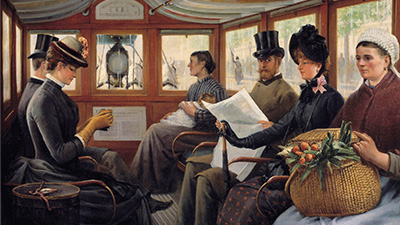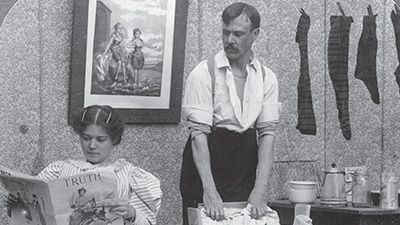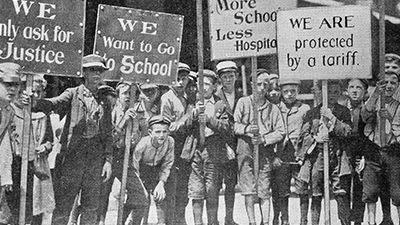Society and the Industrial Age
Teacher Resources
Driving Question: How did industrialization reshape social hierarchies and impact standards of living?
As industrialization spread, employers needed more workers, leading many women and children to join the workforce. Working-class women faced harsh working conditions and were also often left out of public and political life. Over time, growing ideas about gender equality helped spark women’s rights movements. These movements used activism and global connections to fight for voting rights and other important reforms.
Learning Objectives
- Explain how industrialization caused a change in existing social hierarchies and standards of living.
- Use the historical thinking practice of claim testing to comprehend the transformation of gender and class relations in the long nineteenth century.
Vocab Terms:
- bourgeoisie
- class-consciousness
- collective bargaining
- Marxist
- proletariat
- reform
- union
Opener: Society and the Industrial Age
To teach this lesson step, refer to page 3 of the Lesson 5.9 Teaching Guide.
Teachers—and students—love the Urbanization Game. Check out these resources on ways to tweak the activity and this thread for additional resources.
Explore how industrialization impacts where people move and what the physical environment looks like—part of a process called urbanization.
Class Structure
To teach this lesson step, refer to page 6 of the Lesson 5.9 Teaching Guide.
The divide between rich and poor grew exponentially during industrialization. But what led to this huge chasm?
-
Guiding Questions
-
Before you read
Preview the questions below, and then skim the article. Be sure to look at the section headings and any images.
While you read
- What are the two classes that were most impacted by industrialization and what was that impact?
- What is class consciousness?
- What does it mean to say that class is a social construct?
- What was life like for the urban proletariat in the long nineteenth century, according to the author?
- What was life like for the bourgeoisie in the long nineteenth century, according to the author?
- What did Karl Marx believe was the natural relationship between the classes, and what did he argue would eventually happen?
- How did the middle classes come to view the working classes, according to the author, and how did that shape their view of themselves?
- How did Marx’s ideas enter politics in this period?
After you read
- Using evidence provided by the article, explain how industrialization caused change in existing hierarchies and standards of living.
- This author describes the rise of two new (or enlarged) social classes over the course of the long nineteenth century and argues that they had pretty different lives. Do you think the reality was that simple? In other words, did these two classes lead entirely different lives? If not, what might be missing from this analysis? If so, what evidence convinces you?
Claim Testing: Social Class and Gender
To teach this lesson step, refer to page 7 of the Lesson 5.9 Teaching Guide.
Use this Claim and Focus Worksheet to support students in their claim making!
You’ve made plenty of claims in this course. Now, take claim testing a step further and get ready to defend, analyze, or deny some claims!
Changing Gender Roles
To teach this lesson step, refer to page 12 of the Lesson 5.9 Teaching Guide.
The idea of gender changed radically during the nineteenth century. How was the idea of what a man or a woman was influenced by empire, nationalism, and industrialism?
-
Guiding Questions
-
Before you read
Preview the questions below, and then skim the article. Be sure to look at the section headings and any images.
While you read
- What were Victorian ideals of gender roles? How did they spread around the world?
- This period saw the rise of the “new women” in Europe and America. Who were “new women?”
- What kinds of impacts did European imperialism have on women in Asia in this period?
- How did women in Nigeria attempt to use their traditional roles as mothers to protest British taxes and colonialism?
- How did the rise of socialism create potential for change in gender roles?
- Did nationalism create new opportunities for gender equality, or not? Explain your answer.
After you read
- To what extent does this article explain how industrialization caused change in existing hierarchies and standards of living?
- What do you think was the most significant way in which gender roles changed in the period covered in this unit?
- This article also looks at the spread of ideas like nationalism and socialism as forces that could challenge Victorian gender roles, but only to a certain degree. What does this tell us about the role of exchange networks in spreading new ideas about gender, and their limitations?
Contextualizing: Child Labor
To teach this lesson step, refer to page 13 of the Lesson 5.9 Teaching Guide.
Check out this one-pager on contextualization for tips on how to teach this important skill.
Child labor still exists around the today. Read more about how to connect the Sadler report to today in this Community Forum thread.
What it means to be a kid now is radically different than what it meant to be a kid during the nineteenth century. Using the materials below, practice contextualization by examining child labor and changing attitudes towards childhood.
-
Guiding Questions
-
Before you read
Preview the questions below, and then skim the article. Be sure to look at the section headings and any images.
While you read
- How did views about children change in this period in some places, according to the author?
- What limitations does the Matthew Crabtree source have?
- What economic factors made some child labor regulations effective?
- How did children’s work change over time in industrialized societies as a result of these changes?
After you read
- To what extent does this article explain the causes and effects of calls for change in industrial societies from 1750 to 1900?
- According to the article, over a hundred million children still have to work, but child labor is less common than it once was. Based on evidence from this article and other material in this lesson, do you think labor conditions today are better for children—and adults—than they were a hundred years ago? For whom are they better? Explain your reasoning.
- How do the transformations described in this article affect you, today?
CCOT: Transoceanic Interconnections to Revolutions
To teach this lesson step, refer to page 20 of the Lesson 5.9 Teaching Guide.
Want to know more about OER Project’s approach to CCOT? Take a look at this one-pager.
The more things change, the more they stay the same—or do they? You decide by looking at changes and continuities in Unit 5.
Closer: Society and the Industrial Age
To teach this lesson step, refer to page 23 of the Lesson 5.9 Teaching Guide.
The Themes Notebook can be used at the end of the year for AP Exam Review. Check out this post on reviewing resources for the AP Exam.
Do you see any patterns in this unit? It’s time to identify them with the Themes Notebook.






